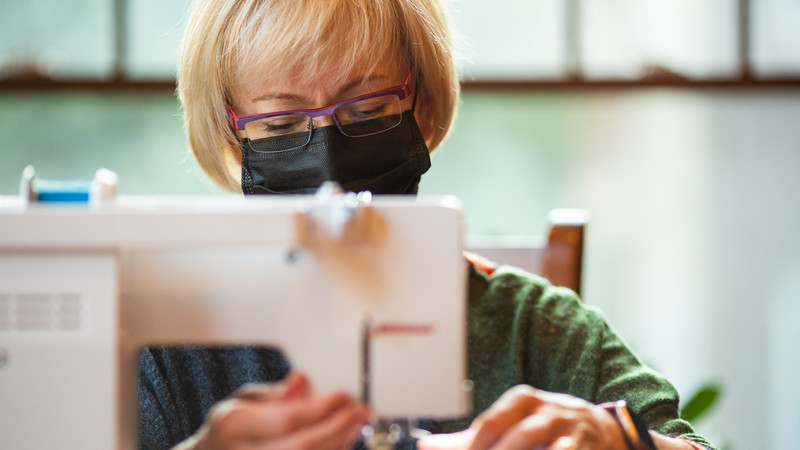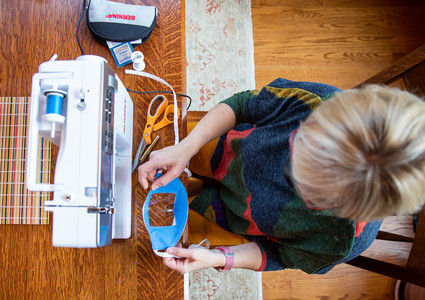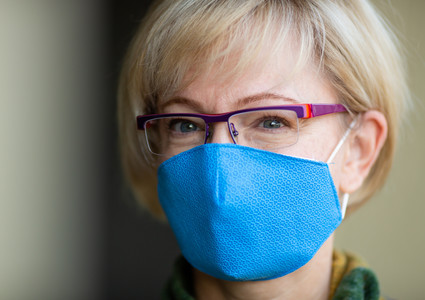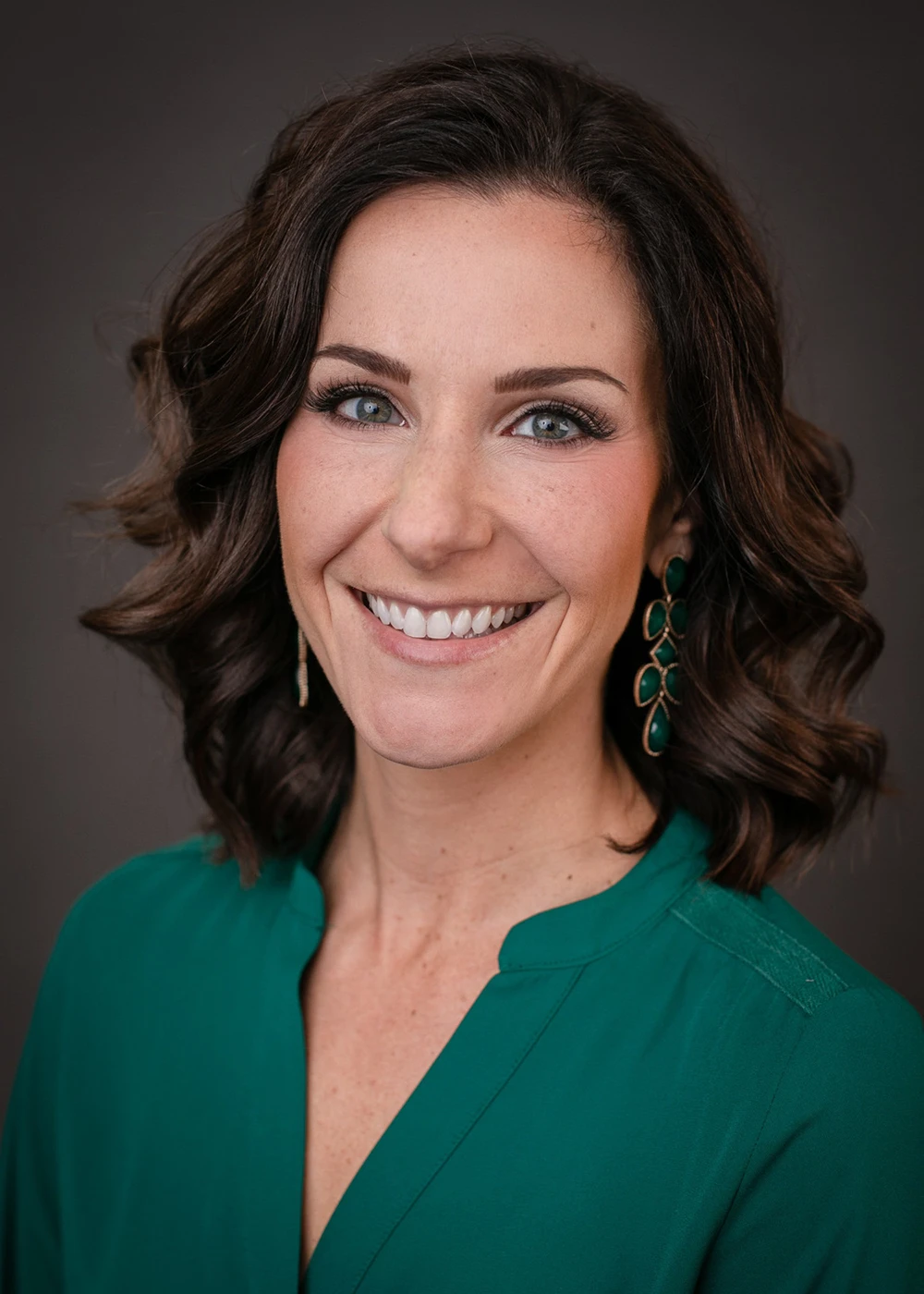




The Meaning of Care Magazine
From Fashion to the Front Lines: A Day in the Life of a COVID-19 Warrior
Published: Nov. 23, 2020“As a 16-year-old, I didn’t have enough money from my part-time job to buy the clothes I wanted,” she said with a laugh. “And you know, I wanted to look cool.”
Being a cashier at Richman Gordman paid her just enough for a small stockpile of shiny gold fabric and shoulder pads. The “very average” Roncalli Catholic high schooler began using her mom’s old sewing machine to channel her inner Madonna.
Aside from lamé pencil skirts, though, sewing also gave her a challenge.
“It’s like, how creative can you be with the least amount of materials? That’s what I love about it.”
The Birth of a Homemade Halyard Gown
As a Methodist Physicians Clinic OB/GYN, Dr. Somer-Shely spends a lot of her time seeing patients and delivering babies at Methodist Women's Hospital. She doesn’t find much time to sew anymore. With COVID-19, however, she saw an opportunity.
“Before this even hit us, my partners had friends from residency who were in Seattle. We were getting messages from them that illustrated complete bedlam – Armageddon, almost,” she said. “They had these crazy stories about people dying, their hospitals overflowing and not having enough PPE (personal protective equipment). That was hard for any of us to imagine.”
By April, the nationwide PPE shortage was starting to be felt locally. Like many area health systems, Methodist was running dangerously low on isolation gowns.
Jerry Kostal, Methodist’s director of purchasing and logistics, reached out to Dr. Somer-Shely.
“We were so lucky to have her abilities and assistance available to us,” he said.
He knew that in March, she helped lead an effort to make cloth coverings for the coveted N95 masks, which were in short supply, too. He had hoped she’d have an idea this time around for the health system’s dwindling gown reserve.
“I knew right away that there had been some information coming out about the filtration quality of Halyard material,” Dr. Somer-Shely said.
Halyard, a nonwoven fabric, traditionally used to keep medical equipment sterile, is plentiful at Methodist.
“I knew it was waterproof, and I knew it was reusable,” she said. “So, I brought some Halyard home from the hospital – stuff that was all going to be thrown away anyway. I wanted to test it out. I washed it. I threw it in with my towels for a week. It didn’t shrink. And it was still waterproof.”
So, she got to work. She made three different prototypes, each made with different material.

“Honestly, the ripstop material I used was the best,” she said. “That’s like a flexible, waterproof nylon that’s used to make outdoor flags or tents. But it was way too expensive.”
The Halyard gowns were effective, washable and, best of all, no additional cost. So, she and several community members wasted no time in sewing more than 190 gowns. In early May, as soon as the gowns were completed, they were laundered so that they’d be ready if needed.
They were needed sooner than expected.
The day after the gowns were professionally cleaned, Dr. Somer-Shely was notified that several employees at Dunklau Gardens at Methodist Fremont Health had tested positive for COVID-19. Providers there were critically low on isolation gowns. The brainchild she intended as a backup plan suddenly became paramount to the safety of frontline workers in Fremont.
“When Jerry told me that the gowns really saved their skin there, that was a big deal to me,” she said. “Just knowing that all that work was for something.”
Little did she know, that “something” would far outlast her week-long washing machine test. Some of those 190 gowns are still being used in Fremont.
Clear Determination

Just a couple weeks after providers at Dunklau Gardens received their gowns, Kostal reached out to Dr. Somer-Shely again.
A hearing-impaired woman was set to deliver her baby at Women’s, and Kostal’s department was trying to secure a clear mask that would allow for lip-reading.
“There was only one type of clear mask that was FDA-approved,” Dr. Somer-Shely said. “But it had been on backorder since January.”
With plenty of Halyard overstock at home, Dr. Somer-Shely obtained some see-through vinyl and sat down at her sewing machine again. Her first attempt at a clear mask was “terrible,” she said.
“It just didn’t fit your face. Sure, you could see the lips, but the filtration was worthless,” she said.
After tweaking her approach with help from a group of Methodist speech therapists, Dr. Somer-Shely introduced a prototype to Methodist Hospital’s service leader for infection prevention and control, Andy Sass.
“He had a problem with the way the clear vinyl was sewed to the mask,” she said. “And he had a point. My needle holes formed a place the virus could potentially travel through.”
Dr. Somer-Shely invested in a heat sealer and even recruited her iron to fuse the vinyl and halyard together.
“That was a mess. And it ruined my iron!” Dr. Somer-Shely said facetiously. “But lo and behold, if you use a waterproof flexible glue, you can sandwich that vinyl in between the Halyard, no problem. It ended up being a heck of a lot better than anything we were going to find on the internet at that point.”
Not only did Dr. Somer-Shely outfit the departments within the health system that needed the masks, but she also sent instructions to a group of geriatricians on the East Coast who were interested in using the masks for their hard-of-hearing patients.
“I should have started an Etsy shop, huh?” she said in jest.
Critical and Creative Efforts
Like many health systems across the region, Methodist temporarily paused elective procedures between mid-March and early May. While many providers were treating fewer patients, that was never the case for Dr. Somer-Shely. Even as she worked tirelessly on various mask and gown prototypes, she was still seeing patients.
“Women were still having babies, right? And when you’re dealing with patients who are both expecting and sick with COVID-19, there’s an extra layer of worry there,” she said. “Aside from that, it was just hard to relax. Even when I wasn’t at work, I felt this overwhelming sense of urgency. I always felt like I needed to be doing something to better help position us for this tidal wave.”
While Women’s may have been less impacted by COVID-19 than the other hospitals of the health system, it was home to just as much planning and just as many protocols aimed at keeping staff and patients safe.
“I really do believe that the things we did and put in place prevented a lot of nurses and doctors from getting sick,” she said. “But me, personally? I didn’t do anything lifesaving. I just sewed a bunch of stuff.”
There are many individuals who beg to differ, though – many who see her COVID-19 role as much more than that of a seamstress.
“From the beginning, the health system has seen a very low record of patient-to-provider transmission,” said Bill Lydiatt, MD, chief medical officer and vice president of medical affairs for Methodist Hospital and Methodist Women's Hospital. “That’s attributed to not only our frontline workers, but also those working feverishly behind the scenes to develop protocols and provide sufficient PPE and supplies.”
“I know how busy Dr. Somer-Shely was,” Kostal said. “And no matter what project I asked her to work on she jumped on it and gave it 110%.”

While she’s traded in her lace gloves for latex gloves, her once-upon-a-time hobby has come full circle. Her sense of fashion is still evident, but now it’s functional and can be seen on the front lines.
Her creativity has soared, no doubt. With the least amount of materials possible.
“I think the most important thing I’ve learned throughout all this is that sometimes – especially when you’re faced with challenges – you’ve got to take risks,” she said. “Sometimes, you’ve just got to try it out – and I guess try it on.”
Photos and video by Daniel Johnson
More Resources
- Learn the difference between a cold, the flu and COVID-19.
- Learn more about OB/GYN services at Methodist
- Get similar articles delivered straight to your inbox.


